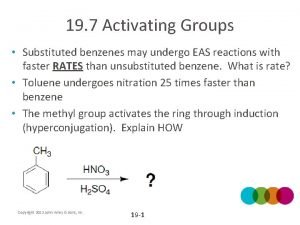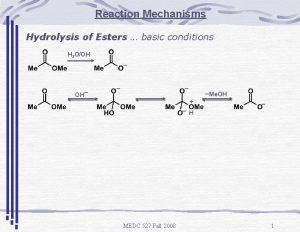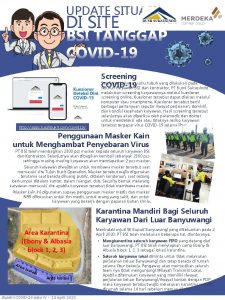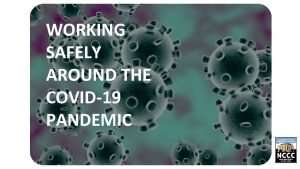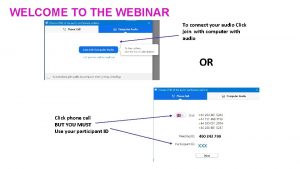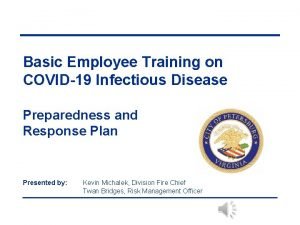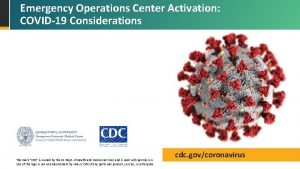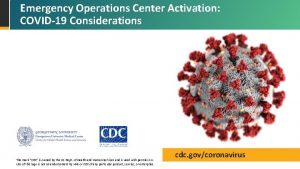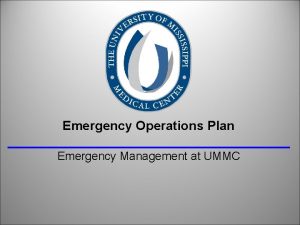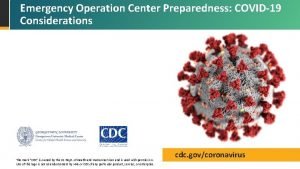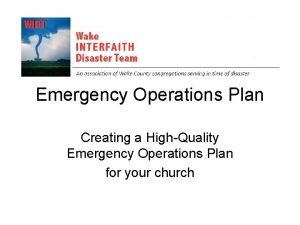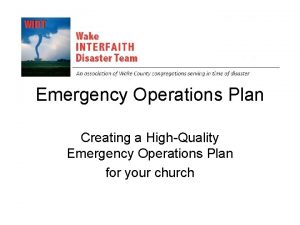Deactivating an Emergency Operations Center COVID19 Considerations The









- Slides: 9

Deactivating an Emergency Operations Center: COVID-19 Considerations The mark “CDC” is owned by the US Dept. of Health and Human Services and is used with permission. Use of this logo is not an endorsement by HHS or CDC of any particular product, service, or enterprise. cdc. gov/coronavirus

Objectives § Explain the Emergency Operations Center (EOC) deactivation process in the context of the COVID-19 response § Discuss possible indicators for deactivation § Describe EOC transition to recovery efforts

EOC Deactivation § Deactivating an EOC – Relates to the progressive cessation of activities as a result of the emergency being under control. – Is a process that needs to occur as the emergency transitions to a pre-incident level. – Should culminate in a post-incident assessment report to evaluate areas of improvement (i. e. , After Action Review).

EOC Deactivation § EOC deactivation is a process that begins while the EOC is activated and requires the attention of EOC staff during the response phase of a public health emergency. § The objective of an EOC is reaching deactivation, because it indicates that the public health threat has been stabilized.

EOC Deactivation Indicators § During the response phase there will be indicators that encourage the transition to long-term recovery activities (i. e. , program management, surveillance, risk communication). § For COVID-19, some indicators might be: – Multi-department involvement is no longer required – Outbreak is limited to a few areas and low numbers of new cases – All cases are linked to known transmission chains – Outbreak is no longer considered a public health threat

EOC Transition to Recovery § Transitioning from response to recovery requires an EOC deactivation plan that will guide recovery operations on an orderly basis. § The following actions will guide the transition (continued on the next slide): – Identifying key activities that must be sustained while the COVID-19 outbreak lasts, including the divisions to manage the activities going forward (i. e. , after the EOC is deactivated). – Incident specific initiatives started as part of the response should be shifted to mitigation and prevention programs for continuation.

EOC Transition to Recovery (Continued from the previous slide) – Recover from interruptions in the supply chain (personal protective equipment (PPE), testing supplies, etc. ) and normalize standardized operating procedures (SOPs). – Resources and equipment made available for the response must be accounted for and returned. • This includes the return of deployed personnel to their preincident responsibilities and duty stations. – Financial accounts created for the COVID-19 incident must be finalized and closed.

References § WHO (2018) Handbook for Developing a Public Health Emergency Operations Centre. Retrieved from https: //apps. who. int/iris/bitstream/handle/10665/277191/9789241515 122 -eng. pdf? sequence=1 § WHO (2015) Framework for Public Health Emergency Operations Centres. https: //www. who. int/ihr/publications/9789241565134_eng/en/

For more information, contact CDC 1 -800 -CDC-INFO (232 -4636) TTY: 1 -888 -232 -6348 www. cdc. gov The findings and conclusions in this report are those of the authors and do not necessarily represent the official position of the Centers for Disease Control and Prevention.
